![]()
![]()
![]()
Use LEFT and RIGHT arrow keys to navigate between flashcards;
Use UP and DOWN arrow keys to flip the card;
H to show hint;
A reads text to speech;
59 Cards in this Set
- Front
- Back
|
Name the 3 components if the cardiovascular system and their function |
Heart - pump Blood - circulating medium Blood vessels - carry blood |
|
|
Where is the heart located? |
In the mediastinum in the thoracic cavity. |
|
|
What is the pericardium and what is its function? |
A double walled sac enclosing the heart, providing a smooth, slippery surface |
|
|
What is the visceral pericardium? |
Inner layer of the pericardium (sac that covers the heart) |
|
|
What is the parietal pericardium? |
Outer layer of pericardium |
|
|
Where is the pericardial fluid found and what is its purpose? |
Found in the pericardial cavity (between the layers of pericardium). Acts as lubricant to allow the membranes to glide over eachother |
|
|
Describe the structure of the heart |
2 Atria at top, 2 ventricles on bottom, Vena cava (veins) and pulmonary trunk & aorta |
|
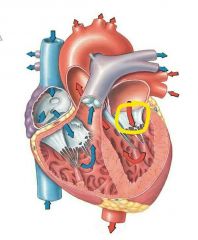
Label this (yellow bit) |
Bicuspid valve |
|
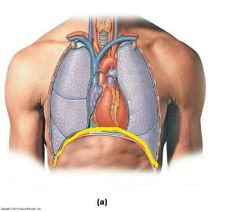
Label this (yellow bit) |
Diaphram |
|
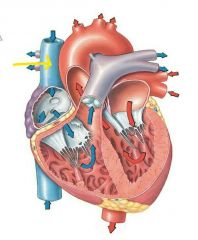
Label this (yellow bit) |
Superior Vena cava |
|
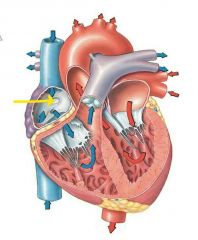
Label this (yellow bit) |
Fosse ovalis |
|
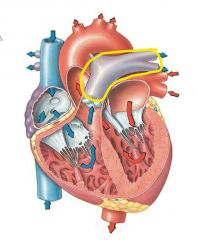
Label this (yellow bit) |
Pulmonary trunk |
|
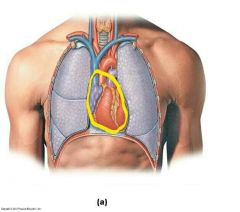
Label this (yellow bit) |
Heart |
|
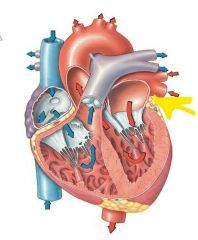
Label this (yellow bit) |
Left atrium |
|
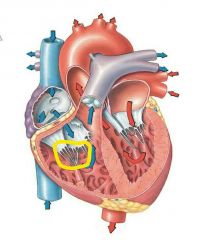
Label this (yellow bit) |
Cordae tendineae |
|
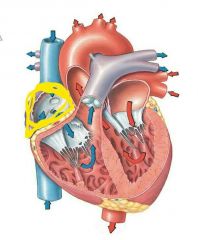
Label this (yellow bit) |
Right atrium |
|
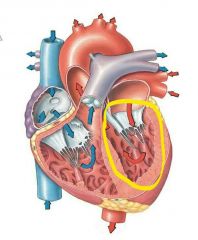
Label this (yellow bit) |
Left ventricle |
|
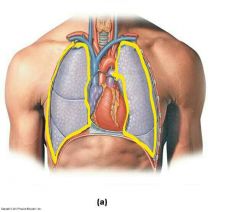
Label this (yellow bit) |
Lungs |
|
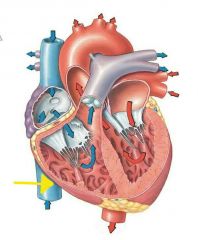
Label this (yellow bit) |
Inferior Vena cava |
|
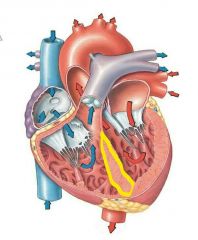
Label this (yellow bit) |
Interventricular septum |
|
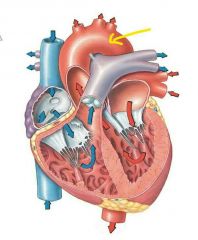
Label this (yellow bit) |
Aorta |
|
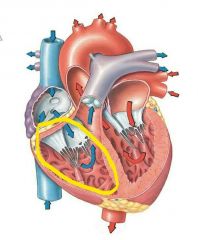
Label this (yellow bit) |
Right ventricle |
|

Label this (yellow bit) |
Tricuspid valve |
|
|
Starting at the Vena cava and finishing at the aorta, describe the path of blood through the heart |
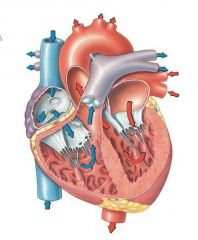
|
|
|
Why are the Atria so thin compared to the ventricles? |
They are simple the receiving chambers of the heart - they do bit need to generate pressure. |
|
|
Which ventricle has thicker walls and why? |
The left ventricle because it has to pump blood all around the body and back |
|
|
What is the function of the valves in the heart |
Prevent back flow and mixing of blood |
|
|
Where is the tricuspid valve located and what is its function |
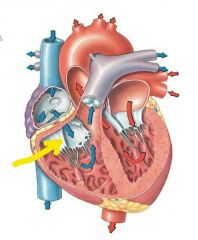
Prevents backflow of blood from right ventricle to right atrium |
|
|
Where is the bicuspid valve located and what is its function? |
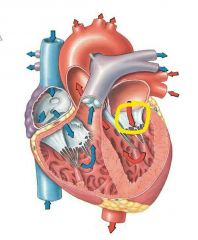
Prevents backflow from left ventricle to left atrium |
|
|
What is the function of the right side of the heart? |
To receive deoxygenated and send it to the lungs for oxygenation |
|
|
What is the function of the left side of the heart? |
To receive oxygenated blood from the lungs and pump it to the rest of the body |
|
|
Describe coronary circulation |
The left and right coronary arteries arise from the base of the aorta and encircle the heart, branching to supply the heart with blood. Cardiac veins drain blood into the coronary sinus which empties into the right atrium |
|
|
Name the components of blood |
Erythrocytes leukocytes Platelets Plasma |
|
|
What is the function of erythrocytes? |
Red blood cells carry haemoglobin which transports oxygen and carbon dioxide |
|
|
What is the function of leukocytes? |
Immunity. They are sensitive to Chemical signs of damage and leave the bloodstream and enter damaged tissue to remove toxins/pathogens/abnormal&damaged cells |
|
|
What is the function of platelets? |
Blood clotting (haemostasis) |
|
|
What is the function of plasma? |
Liquid portion that carries proteins and nutrients |
|
|
What are albumins? |
Plasma proteins that contribute to osmotic pressure |
|
|
What are globulins? |
Plasma proteins that defend against disease (including antibodies) |
|
|
What is fibrinogen? |
Plasma protein which forms blood clots. Fibrinogen is converted into insoluble strands of fibrin |
|
|
List the physical characteristics of blood |
Viscous and slightly sticky 38°C Bright red - dark red Alkaline (pH 7.35-7.45) |
|
|
List the functions of blood |
Transport Regulation of pH Restriction of fluid losses Defence (immunity) Stabilization of body temp Stabilizing blood pressure |
|
|
Describe the structure of erythrocytes |
No nucleus and lack organelles. Biconcave shape for flexibility and surface area, Red because of iron mixing with oxygen. Each haemoglobin molecule can carry 4 oxygen molecules |
|
|
What is the structure of leukocytes? |
White blood cells have a nucleus and organelles. Much larger than red blood cells, but only 1% of TBV |
|
|
Describe the role of platelets in the formation of a blood clot |
Activated platelets stick together to form a 'plug' |
|
|
List the 5 different types of white blood cells |
Lyphocytes Monocytes Neutrophils Eosinophils Basophils |
|
|
What are haemocytoblasts? |
Stem cells that form red blood cells |
|
|
What is erythropoietin? |
A hormone released by the kidneys that controls the formation of red blood cells |
|
|
What is biliverdin? |
The greenish substance formed when the remainder of a red blood cell is broken down |
|
|
What is biliverdin eventually broken down to? |
Bilirubin |
|
|
What is plasma called once all the clotting proteins have been removed? |
Serum |
|
|
Name the 2 components of the lymphatic system |
▪Lymphatic vessels and lymph ▪Lymphatic tissue and lymphoid organs |
|
|
Name the 3 functions of the lymphatic system |
Regulation if interstitial fluid Absorption of dietary fats Immune function |
|
|
What are lacteals? |
Lymphatic vessels that absorb dietary fats |
|
|
What is lymph? |
Excess interstitial fluid to be returned to the blood stream by the lymphatic system |
|
|
Describe how the lymphatic system returns fluid to the circulatory system |
From the collecting capillaries, the lymph flows into larger vessels which eventually flow into lymphatic ducts, which empty into veins, into superior Vena cava |
|
|
How does the lymph return to the circulatory system without a pump? |
▪Pulsation of nearby arteries ▪Contraction of skeletal muscle ▪Contraction of smooth muscle in walls of lymphatics ▪Valves that prevent backflow |
|
|
What is the function of the right thoracic duct |
Collect lymph from the rest of the body and returns it to the bloodstream at the junction of the internal jugular and subclavian veins |
|
|
What is the function of the right lymph duct? |
Drains lymph from the right side of the body above the diagram and empties into the right subclavian vein |

